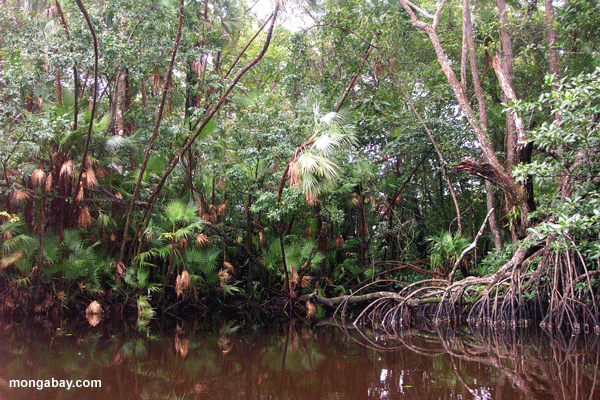 Mangroves in Honduras |
Mangroves are under-appreciated assets in the effort to slow climate change, argues a new Proceedings of the National Academy of Sciences paper which makes a argument for including the coastal ecosystems in carbon credit programs.
The study, authored by researchers from Resources for the Future and University of California at Davis, estimated the cost of reducing greenhouse gas emissions by preserving mangrove forests, which globally store 6.5 billion tons of carbon in their biomass and soils despite representing only 0.7 percent of global tropical forests. They found that most emissions from mangrove destruction and degradation could be avoided at less than a cost of $10 per ton of carbon dioxide, roughly 20 percent above the current price for compliance-grade carbon offsets in Europe.
But protecting mangroves would offer further benefits beyond emissions mitigations. The ecosystems are known to offer a number of other important services, including buffering coastlines from erosions and storms, serving as a nursery for fisheries, and providing habitat for biodiversity. Mangroves thus form the basis for livelihoods in many parts of the developing world.
 Mangroves in Panama. Photos by Rhett A. Butler |
The authors note that despite their role in sequestering carbon and affording other ecosystem services, mangroves aren’t currently a focus of the Reducing Emissions from Deforestation and Degradation (REDD+) program that aims to compensate tropical countries for safeguarding forest carbon stocks. Yet mangroves are being cleared at an even faster clip than tropical forests, according to data from the U.N., so opportunities to capitalize on their services is dwindling. The researchers thus suggest further study into whether mangrove conservation could be integrated into the REDD+ program.
“Mangroves may already fit within the general REDD architecture,” the authors write. “Our results suggest the need for practical evaluations of mangrove-based carbon offsets, including rigorous local assessments of offsets as well as developing their robust verification and monitoring.”
CITATION: Juha Siikamäki, James N. Sanchirico, and Sunny L. Jardine. Global economic potential for reducing carbon dioxide emissions from mangrove loss. PNAS July 30, 2012. doi: 10.1073/pnas.1200519109
Related articles
Vanishing mangroves are carbon sequestration powerhouses
(04/05/2011) Mangroves may be the world’s most carbon rich forests, according to a new study in Nature Geoscience. Measuring the carbon stored in 25 mangrove forests in the Indo-Pacific region, researchers found that mangroves forests stored up to four times as much carbon as other tropical forests, including rainforests. “Mangroves have long been known as extremely productive ecosystems that cycle carbon quickly, but until now there had been no estimate of how much carbon resides in these systems. That’s essential information because when land-use change occurs, much of that standing carbon stock can be released to the atmosphere,” explains co-author Daniel Donato, a postdoctoral research ecologist at the Pacific Southwest Research Station in Hilo, Hawaii.
Satellites show mangrove forest loss even worse than estimated

(08/19/2010) New satellite data shows that human actions are wiping out mangrove forests even faster than previous bleak estimates. Conducted by the US Geological Survey and NASA, the researchers found that mangroves comprise 12.3 percent less area than previously estimated. In total, satellites reveal that mangrove forests cover approximately 53,290 square miles (137,760 square kilometers). “Our assessment shows, for the first time, the exact extent and distribution of mangrove forests of the world at 30 meters spatial resolution, the highest resolution ever,” said Dr Chandra Giri from USGS.